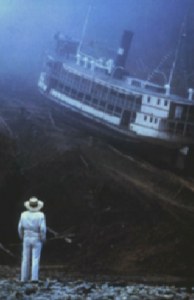| Fitz really has nothing but his crazy
dream, and no specific logistics to make it work. How
will he get past the local headhunters? Even if he gets
there, how will his crew of twenty guys and a winch
manage to drag a steamship over a mountain? Amazingly enough,
he pulls it off. He soothes the local headhunters with
his recordings of Caruso, gets a local indian tribe to
assist him with all their manpower, and together they
drag the boat over the mountain and place it in the other
river.
Of
course, the achievement of the impossible calls for a
celebration. The Europeans and the Indians dance and
drink well into the night, and when Fitz wakes up, he
finds that his boat has drifted back downstream into the
deadly rapids. It turns out that the indians felt that
the boat needed to be cast adrift in the deadly rapids to
appease the evil water spirit. Amazingly, the boat and
Fitz do survive and eventually drift back to Iquitos.
The
dreamer did the impossible and lost everything the next
day. Then he faced sure death and survived.
He still
has his steamship, so he agrees to sell it to one of the
rubber barons. With the profits, he rents the Manaus
opera company for one night, and does manage to stage a
grand opera in Iquitos - on the steamship as it sails.
The film ends, as it began, with the presentation of an
opera, but this one alfresco at full steam.
If that
sounds to you like a great adventure, you are right. It
is, in many ways, one of the greatest films ever made.
The basic story is great, the images are spectacular, and
the realism is incomparable. Why do I make a special note
of the realism? Because Werner Herzog actually duplicated
all of the actions portrayed in the movie. They didn't
use any miniatures or camera tricks. They actually
refurbished an old steamship and dragged it over a peak
covered with tropical vegetation, and they actually used
an old-fashioned winch and indigenous people to do most
of the work. Then they took that steamship and floated it
through some rapids for the next scene. The only false
note was struck in the fact that the ship was obviously
deserted when it was filmed shooting through the
dangerous rapids, although it was not supposed to be. But
that's a minor point. It looks like they were actually
there doing all those things because they were! It took
them three years, filming non-stop in the jungle, to make
the film, even working around a border war between Peru
and Ecuador.
To make
the film more interesting, they never translated the
natives' language, which left the viewers in the POV of
Fitz and the crew, never quite sure what the natives
wanted, always wondering if they were going to be killed
in the night. In addition to those positives, the
photography is beautiful, and the DVD transfer is
excellent except for the first couple of minutes. (I
guess there was some damage to the source media in that
short opening stretch)
|
DVD info from Amazon.
Widescreen anamorphic,
enhanced for 16x9 screens
The audio track is
available in both German and English. It
was originally filmed in English.
There is also a
full-length commentary track from Werner
Herzog.
|
|
Unfortunately,
the film isn't easy to watch. My description probably
makes it sound more exciting than it is. It is 157
minutes long, the dialogue is sparse, and the individual
scenes sometimes go on way too long. But it's still a
helluva movie. By the way, noted nutball Klaus Kinski
almost didn't make it through the movie. As you may know,
Kinski was despised by pretty much everyone who ever met
him. Herzog had worked with him before and didn't want
him, but his first star (Warren Oates) died, and his
replacement (Jason Robards) took ill. Fitz's sidekick
(Mick Jagger) had to honor his other commitments. Kinski
was available, so they wrote out the sidekick completely,
made the dialogue suitable to Kinski, and moved on. At
one point the natives, who hated Kinski as much as
everyone else, came to Herzog and asked if they should
kill him for real!
Quite a
story. The film is good, but the story behind it is
incredible.
|

